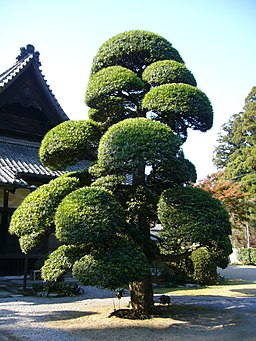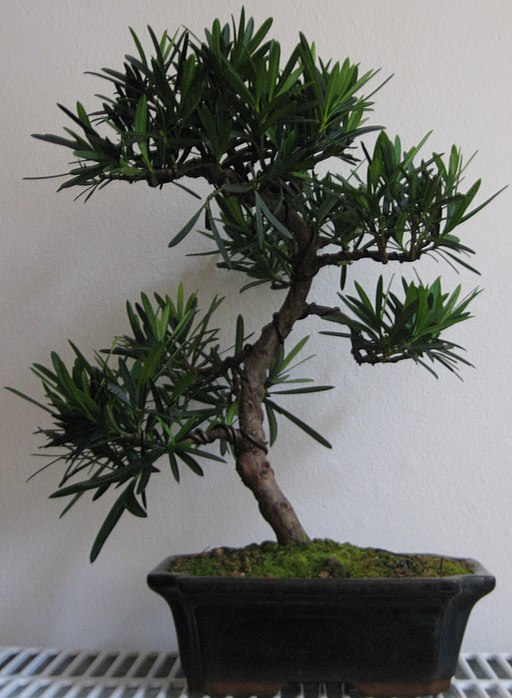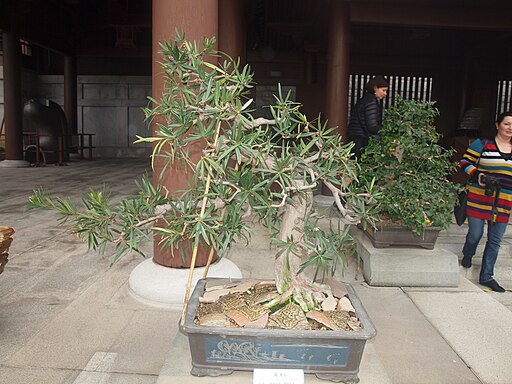 |
Many Little monks coming out to pray in 2020 |
Podocarpus macrophyllus
Yew Pine
Southern Yew
Buddhist Pine
Kusamaki
Inumaki
Luo Han Song
 |
Foliage with mature seed cones |
The oval-shaped fruit which seated on thick fleshy receptacle turns reddish/purplish when ripened, which looks like a little Monk in a purple robe praying . The ripe purple-red fruit on female plants are edible, though the seed is not, and makes a good wine or jelly...
USDA Hardiness Zone: 7 to 10
Podocarpus can grow to forty feet with a spread of about twenty.
Native to southern China and Japan
 |
Likes slightly moist soil, as its root ball must not be allowed to dry out |
Podocarpus have a strong apical growth habit remedied by cutting them back hard, which will result in aggressive back budding. Wire new wood for 2-3 months, being careful to watch for any signs that the wire is beginning to cut into the bark. Green shoots may be wired loosely. Old Podocarpus wood becomes very rigid as it ages and will be difficult to bend.
Likes slightly moist soil, as its root ball must not be allowed to dry out, but provide adequate drainage.
Podocarpus can be grown successfully indoors in a well-lit cold house. Like most conifers, it has a tendency to dry out without proper humidity, and will prefer being kept away from dry heat. For the long term health of the tree summer outside. USDA hardiness zones: 8B through 11.
 |
provide adequate drainage. |
In cold climates, Podocarpus can be grown successfully indoors in a well-lit cool house environment. Prefers winter temperatures above freezing, do not allow the roots to freeze. Like most conifers, it has a tendency to dry out without proper humidity, and will prefer being kept away from dry heat.
Podocarpus roots are of two kinds: long-branching roots and short-branching coralloid roots, which form symbiotic associations between plant roots and fungi. The plant provides carbon to the fungus, and the fungus greatly increases plant acquisition of phosphorus There is no strong evidence for nitrogen fixation in the nodules. Repot every 3-4 years in spring. Roots should only be lightly pruned, and only when the roots have become very dense.
Podocarpus likes slightly acid soil with enough magnesium and iron; apply a dose of chelated iron twice yearly. To prevent magnesium deficiency, use 2-3 applications of Epsom salts (1 tbs per gallon of water) a year.
 |
"Podocarpus macrophyllus, Satori-city,Japan" |
Buddhist Pine is highly regarded as a feng shui tree. The Tree, which is not a true pine but a podocarp, is thought to be the harbinger of good fortune. Along with the Bodhi Tree, the Buddhist Pine plays at important inspirational role in Buddhist religion. The fleshy red seeds represent 'disciples' of the Buddha, assuring its owner of never being impoverished. Many believe the pine attracts good health, and that the wealth is a by-product of being healthy
 |
Podocarpus macrophyllus bonsai |
If you're buying a collected tree, be sure it has been in its current container for at least a couple of years.
 |
Podocarpus macrophyllus. |
Bonsai is often used in the life improvement system of feng shui and are known to be grown on temple grounds of China.
 | |
Podocarpus macrophyllus of Odawara Castle Ruins |
 |
Buddhist Pine Bonsai in Phipps Conservatory |
If you're buying a Buddhist pine tree bonsai, it's best to purchase a plant with the size trunk you want. Podocarpus trunks develop very slowly, especially in a container.

please tell what kind of podocarpus in the picture at the top
ReplyDelete